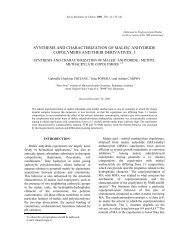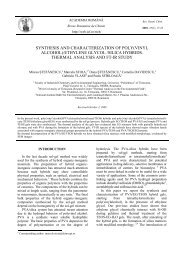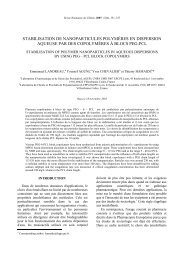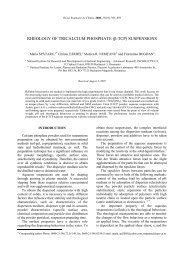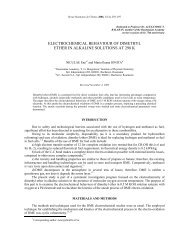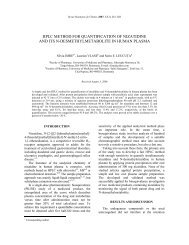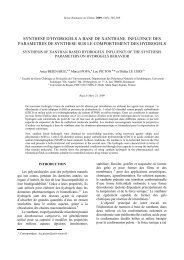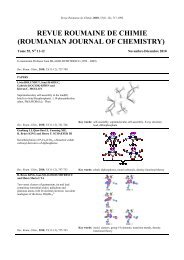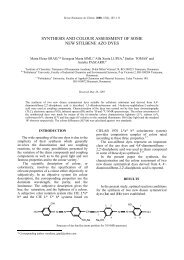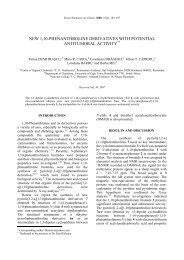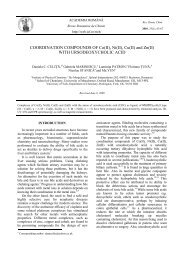3D HOMOLOGY MODEL OF THE α2C-ADRENERGIC RECEPTOR ...
3D HOMOLOGY MODEL OF THE α2C-ADRENERGIC RECEPTOR ...
3D HOMOLOGY MODEL OF THE α2C-ADRENERGIC RECEPTOR ...
Create successful ePaper yourself
Turn your PDF publications into a flip-book with our unique Google optimized e-Paper software.
ACADEMIA ROMÂNĂRevue Roumaine de Chimiehttp://web.icf.ro/rrch/Rev. Roum. Chim.,2012, 57(7-8), 763-768Dedicated to Professor Victor-Emanuel Sahinion the occasion of his 85 th anniversary<strong>3D</strong> <strong>HOMOLOGY</strong> <strong>MODEL</strong> <strong>OF</strong> <strong>THE</strong> α 2C -<strong>ADRENERGIC</strong> <strong>RECEPTOR</strong> SUBTYPELiliana HALIP, * Alexandra T. GRUIA, Ana BOROTA, Maria MRACEC,Ramona F. CURPAN and Mircea MRACECChemistry Institute Timişoara of Roumanian Academy, 24, M.Viteazul Av., RO-300223, Timişoara, RoumaniaReceived October 22, 2010Comparative modeling of the three-dimensional structure of the human α 2C adrenoceptor (α 2C -AR) based on the high-resolutionX-ray structure of the human β 2 -AR (2RH1, PDB file) is reported. The sequence of the α 2C -AR subtype was aligned with thesequence of the 2RH1 template and the <strong>3D</strong> homology model of the α 2C -AR was built using the Modeller software. Thestereochemical quality of the <strong>3D</strong> homology model was checked by using PROCHECK software and its accuracy was established bydocking the endogen ligand, norepinephrine.INTRODUCTION *α 2C -Adrenergic receptor (α 2C -AR) belongs toclass A of the large family of G protein-coupledreceptors (GPCRs). The progress in experimentalstudies on distribution, polymorphism, cloning,function, physiology, pharmacology and clinicalapplications of α 2 -ARs is discussed in severalrecently published reviews. 1-5The α 2C -AR is present in the adrenal medulla,where it mediates the epinephrine release and inthe central nervous system (CNS), where itparticipates with α 2A -AR in the presynapticinhibition of norepinephrine release. 6 The α 2C -ARis also expressed in kidney and cutaneous bloodvessels where it is supposed to contribute to coldinducedvasoconstriction. 7 Like α 2A -AR, the α 2C -AR has a contribution to the spinal nociception andopioid synergy induced by moxonidine. 8 The α 2C -AR has a distinct inhibitory role in various CNSmediatedbehavioral and physiological responsessuch as amphetamine-induced locomotor hyperactivityand aggressive behavior. 9 In the last years thenumber of potential therapeutic uses of the α 2C -ARincreased rapidly and led to a stringent need forpotent and selective α 2C -AR agonists and antagonists.The most rapid and less expensive manner ofapproaching such a challenging task is the computeraideddrug design (CAMD). A common approach isvirtual screening based on similarity criteria anddocking conformers of ligands from large libraries.When the experimentally determined <strong>3D</strong> structure ofthe target protein is not known, accurate models ofthe <strong>3D</strong> structure now can be obtained either by abinitio, or by homology modeling methods. Theprogress in the methodological approaches andstructural features of the <strong>3D</strong> homology models of α-ARs was recently published. 10One of the most important steps in homologymodeling technique is the identification of a goodtemplate structure. Such a structure must fulfillsome requirements: the resolution of its X-Rayspectrum must be equal or better than 2.5 Å, thesequence identity with the target protein must behigh (at least 30%), and the biological function ofthe two proteins must be similar or at least related.* Corresponding author: lili_ostopovici@gmail.com
764 Liliana Halip et al.The first template used for building <strong>3D</strong>homology models of α-ARs was the structure ofbacteriorhodopsin. The <strong>3D</strong> models 11,12 based onthis template were followed by those 12-17 based ona true GPCR template, namely the X-ray structureof bovine rhodopsin obtained at differentresolutions by Palczewski 18 , Teller 19 and Okada. 20Recently, other GPCR structures have been solved:the human β2-AR 21 , the turkey β1-AR 22 , the squidrhodopsin 23 and the human adenosine A2Areceptor. 24 Thanks to these findings new insightsinto ligand binding and the structural changesrequired to accommodate catecholamine agonistshave been provided.In this paper we report the building, refinementand geometrical characteristics of a <strong>3D</strong> homologymodel of α 2C -AR based on a high-resolution(2.4 Å) crystal structure of the human β 2 -AR 21crystallized with the inverse agonist carazolol.Despite the missing of the third intracellular loop,the β2-AR-T4L chimera protein was shown toretain near-native pharmacologic properties ofβ2-AR. 21METHODSThe sequence of 2RH1 and human α 2C -AR wereextracted from Protein Data Bank (PDB) andSwissProt database respectively. 25 The twosequences have been automatically aligned withT-coffee 26,27 and manually refined. The finalalignment was used to generate the homologymodel of α 2C -AR using Modeller software 28,29based on the X-ray structure at 2.4 Å resolution ofthe human β 2 -AR, PDB code file 2RH1. 21 Theresulted <strong>3D</strong> model was first stereochemicallyevaluated using the Procheck software 30,31 andthen, refined with Protein Preparation Wizard 32included in the Schrödinger suite 2009. Afterrefinement the model was validated by docking itsendogen ligand, norepinephrine, using Induced FitDocking module from the Schrödinger software. Inthe process of docking, both ligand and receptorwere flexible. The primary binding site of α 2C -ARwas identified by using SiteMap application 33implemented in Schrödinger suite.Norepinephrine was prepared for docking usingLigPrep 2.1 application 34 . For this purpose, theionization state was set according to physiologicalconditions (pH range 7±0.2). Finally, the geometrywas optimized using OPLS2005 force field.RESULTSThe Ballesteros-Weinstein convention 35 wasused for amino acid numbering in the sequences ofthe two proteins. In this convention the mostconserved amino acid on a certain helix isarbitrarily noted with 50 preceded by the numberof the helix, n. The rest of the amino acids on ahelix are numbered relative to n.50 position. Forexample on helix 3 the most conserved amino acidis an Arg residue noted Arg3.50. The precedentamino acid is Asp3.49 and the following aminoacid after Arg3.50 is a Tyr3.51. This sequenceAsp-Arg-Tyr (or DRY in one letter notation ofamino acids) is one of the most conservedsequences in the GPCR family.The alignment of the α 2C -AR and 2RH1sequences revealed the absence of the followingfragments in the <strong>3D</strong> structure of the β 2 -AR: Asn1 –Arg28, Gln231 – Ser262, Arg343 – Leu413. Thesequence Pro230 – Arg363 from the thirdintracellular loop of the α 2C -AR has nocorrespondent sequence in the 2RH1 template,because it corresponds to the T4 lysozyme (T4L).Therefore, the third intracellular loop of the α 2C -AR was deleted from Thr241 to Val372. Thisaction does not influence the interactions from thebinding pocket, which is located in thetransmembrane (TM) region. In the final alignmentthe proper alignment of the highly conservedresidues was checked. 36 In the α 2C -AR sequencethe following conserved amino acids (numberedaccording to the Ballesteros-Weinstein convention)were identified: on the TM1 Gly1.49, Asn1.50 andVal1.53, on TM2 Ser2.45, Leu2.46, Ala2.47,Ala2.49 and Asp2.50, on TM3 Ser3.39, Leu3.43,Ile3.46, Ser3.47 (Ala3.47 on 2RH1), Asp3.49,Arg3.50, Tyr3.51, Val3.54 (Ile3.54 on 2RH1), onTM4 Trp4.50, Ser4.53 and Pro4.60, on TM5Phe5.47, Pro5.50, Ile5.53, Tyr5.58 and Ile5.61(Val5.61 on 2RH1), on TM6 Arg6.32 (Lys6.32 on2RH1) Phe6.44, Cys6.47, Trp6.48, Pro6.50, onTM7 Asn7.45, Ser7.46, Asn7.49, Pro7.50,Tyr7.53, Phe7.60 and Arg7.61. Other conservedamino acids, such as Asp131 (Asp3.32 on TM3),Ser214 (Ser5.42 on TM5), and Ser218 (Ser5.46 onTM5), are implicated in interaction with α 2C -ARagonists and antagonists. The final alignment afterdeletion of the amino acids from the thirdintracellular loop is shown in Fig. 1.The model building was carried out usingModeller software 28,29 based on the final alignmentshown in Fig. 1.
<strong>3D</strong> homology model 765Fig. 1 – Sequence alignment of the hα 2C -AR and hβ 2 -AR (PDB 2RH1) sequences.Bold characters – alpha helices; gray background – highly conserved amino acids in the GPCR family; underlined – the n.50 amino acid onthe helix ‘n’ in the Ballesteros-Weinstein convention. The helix number is marked above the first and the last residue from that helix.From stereochemical point of view, asatisfactory homology model should have over90% residues in the most favored regions of theRamachandran plot. 37 Therefore, the initial <strong>3D</strong>model of the α 2C -AR was refined in several steps.To avoid close contacts and to correct somedistorted bond angles or planarity of somearomatic rings signaled by PROCHECK thegeometrical parameters of certain residues havebeen optimized with AMBER99 force field. Thegeometry of the final model had all geometryparameters in the normal limits.The refined <strong>3D</strong> model of α 2C -AR contained 228residues in the most favored regions (91.6 % in A,B, L regions of the Ramachandran plot), 21residues in the additional allowed regions (8.4 % ina, b, l, p regions) and no residues in each ofgenerously allowed (0.0 % in ~a, ~b, ~p, ~lregions), and in disallowed regions (0.0 % in whitearea). The Ramachandran map for the refined <strong>3D</strong>model of the α 2C -AR based on 2RH1 template isdisplayed in Fig. 2.Using the Procheck software the main-chainparameters (peptide bond planarity, bad nonbondedinteractions, Cα distortion, overall G-factor), main-chain bond length distributions,main-chain bond angle distributions, and sidechainparameters of residues were also verified andfound to be in the admitted error limits or better.The homology model of α 2C -AR, represented as asolid ribbon is displayed in Fig. 3.Mutagenesis studies 38 performed on α 2A -ARshowed that amino acid residues important forligand binding and receptor activation by agonistsare Asp3.32 and Ser5.46. The sequence identitybetween α 2A -AR and α 2C -AR is extremely high(over 85%) and the Asp3.32 and Ser5.46 residuesare being conserved within α 2 -ARs. Therefore asimilar binding mode of norepinephrine in theα 2C -AR binding site is expected. To check themodel accuracy with regard to experimental data,the endogen ligand of all adrenergic receptors,norepinephrine, was docked in the α 2C -AR bindingsite using InducedFit protocol. A grid that includedthe ligand binding domain resulted from SiteMap 33 was used for docking the norepinephrine.The best pose of the α 2C -norepinephrine complexobtained from docking is displayed in Fig. 4.+As one can see in Fig. 4, the protonated NH 3group of norepinephrine is favorably placed andoriented to electrostatically interact (salt bridgeformation) with the negatively charged carboxylicgroup from Asp3.32 (Asp131) side chain (3.3Å).In addition, the hydroxyl groups found in meta andpara positions of the catecholic ring formhydrogen bonds with the hydroxyl groups from Ser5.42 and Ser5.46 side-chain. The output of dockingthe endogen ligand in α 2C -AR supports theexperimental data obtained through site-directedmutagenesis and provides evidence that homologymodel is reliable and it can be used in furtherstudies.
766 Liliana Halip et al.Fig. 2 – Ramachandran map for α 2C -AR after refinement steps.Fig. 3 – The <strong>3D</strong>-structure of α 2C -AR obtained by homology modeling using the 2RH1 structure as template.Norepinephrine binding pocket is highlighted with dark black surface.
768 Liliana Halip et al.15. F. Gentili, F. Ghelfi, M. Giannella, A. Piergentili, M.Pigini, W. Quaglia, C. Vesprini, P.A.; Crassous, H. Parisand A. Carrieri, J. Med. Chem., 2004, 47, 6160-73.16. B. Balogh, Cs. Hetenyi, M.G. Keseru and P. Matyus,Chem. Med. Chem., 2007, 2, 801-805.17. B. Balogh, A. Szilágyi, K. Gyires, D. Bylund and P.Mátyus, Neurochem. Int., 2009, 55, 355-361.18. K. Palczewski, T. Kumasaka, T. Hori, C.A. Behnke, H.Motoshima, B.A. Fox, I. Le Trong, D.C. Teller, T.Okada, R.E. Stenkamp, M. Yamamoto and M. Miyano,Science, 2000, 289, 739-745.19. D.C. Teller, T. Okada, C.A. Behnke, K. Palczewski andR.E. Stenkamp, Biochemistry, 2001, 40, 7761-72.20. T. Okada, M. Sugihara, N. Bondar, M. Elstner, P. Enteland V.J. Buss, J. Mol. Biol., 2004, 342, 571-583.21. V. Cherezov, D.M. Rosenbaum, M.A. Hanson, S.G.F.Rasmussen, F.S. Thian, T.S. Kobilka, H.-J. Choi, P.Kuhn, W.I. Weis, B.K. Kobilka and R.C. Stevens,Science, 2007, 318, 1258-65.22. A. Warne, M.J. Serrano-Vega, J.G. Baker, R.Moukhametzianov, P.C. Edwards, R, Henderson, A.G.W.Leslie, C.G. Tate and G.F.X. Schertler, Nature, 2008,454, 486-91.23. M. Murakami and T. Kouyama, Nature 2008, 453, 363-367.24. V.P. Jaakola, M.T. Griffith, M.A. Hanson, V. Cherezov,E.Y. Chien, J.R. Lane, A.P. Ijzerman and R.C. Stevens,Science 2008, 322, 1211-1217.25. http://www.expasy.org/sprot/sprot-top.html26. C. Notredame, D.G. Higgins and J. Heringa, J. Mol. Biol.,2000, 302, 205-217.27. O. Poirot, E. O'Toole and C. Notredame, Nucl. AcidsRes., 2003, 31, 3503-3506.28. Sali and T.L. Blundell. J. Mol. Biol., 1993, 234, 779-815.29. N Eswar, M.A. Marti-Renom, B. Webb, M.S.Madhusudhan, D. Eramian, M. Shen, U. Pieper, andA. Sali, Current Protocols in Bioinformatics, 2007, 15,561-5630.30. T. Schwede, J. Kopp, N. Guex and M.C. Peitsch, Nucl.Acids Res., 2003, 31, 3381-5.31. N. Guex and M.C. Peitsch, Electrophoresis, 1997, 18,2714-2723.32. Protein Preparation Wizard; Schrödinger LLC, NewYork, NY 2007.33. SiteMap version 2.1; Schrödinger LLC, New York, NY2007.34. LigPrep version 2.1; Schrödinger, LLC, New York, NY2007.35. J. Ballesteros, H. Weinstein. Methods Neurosci 1995, 25,366-428.36. J.M, Baldwin, G.F.X. Schertler, V.M. Unger, J Mol Biol.,1997, 272, 144-164.37. G.N. Ramachandran, C. Ramakrishna and V. Sasisekharan,J.Mol.Biol., 1963, 7, 95-9.38. C.-D. Wang, M.A. Buck and C.M. Fraser, Mol.Pharmacol., 1991, 40, 168-179.



